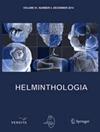Larvae trypanorhynch (Cestoda) infecting the dusky flounder, Syacium papillosum (Paralichthyidae: Pleuronectiformes) in the continental shelf of the Yucatan Peninsula, Mexico
IF 1.2
4区 生物学
Q4 PARASITOLOGY
引用次数: 0
Abstract
Summary Trypanorhynch cestode larvae were found parasitizing specimens of dusky flounder墨西哥尤卡坦半岛大陆架上感染暗纹比目鱼(Syacium papillosum, Paralichthyidae: Pleuronectiformes)的绦虫(Cestoda)幼虫
摘要 在墨西哥东南湾(s-GoM)发现了寄生在比目鱼标本上的 Trypanorhynch绦虫幼虫。共从 194 条嵌入肠道和胃壁的比目鱼身上发现了栉水母。通过形态学和新测序的部分 28S(D1-D3 区域)核糖体 DNA 分子系统发育,并结合 GenBank 中其他种类跃层鱼的数据,对跃层鱼进行了鉴定。在 s-GoM 的暗纹比目鱼标本中发现了三个属的绦虫幼体,分别是 Nybelinia Poche, 1926; Kotorella Euzet & Radujkovic, 1989 和 Oncomegas Dollfus, 1929。这些桡足类代表六个物种:1、Nybelinia sp.2、Nybelinia sp.3、Nybelinia sp.4、Kotorella pronosoma (Stossich, 1901) 和 Oncomegas wageneri (Linton, 1890) Dollfus, 1929。本研究中的所有绦虫标本都是各自物种的新地点记录。
本文章由计算机程序翻译,如有差异,请以英文原文为准。
求助全文
约1分钟内获得全文
求助全文
来源期刊

Helminthologia
生物-动物学
CiteScore
1.80
自引率
0.00%
发文量
21
审稿时长
>12 weeks
期刊介绍:
Helminthologia (HELMIN), published continuously since 1959, is the only journal in Europe that encompasses the individual and collaborative efforts of scientists working on a different topics of human, veterinary and plant helminthology. The journal responsibility is to enrich the theoretical and practical knowledge in very specific areas and thus contribute to the advancements in human and veterinary medicine and agronomy. Taking the advantage of comprehensive and multidisciplinary approaches journal still maintains its original spirit and is principal source of fresh scientific information regarding helminths, endoparasites and plant parasites. Addressing the most up-to date topics journal gained rightful and exceptional place next to the other high-quality scientific journals publishing in its field.
 求助内容:
求助内容: 应助结果提醒方式:
应助结果提醒方式:


